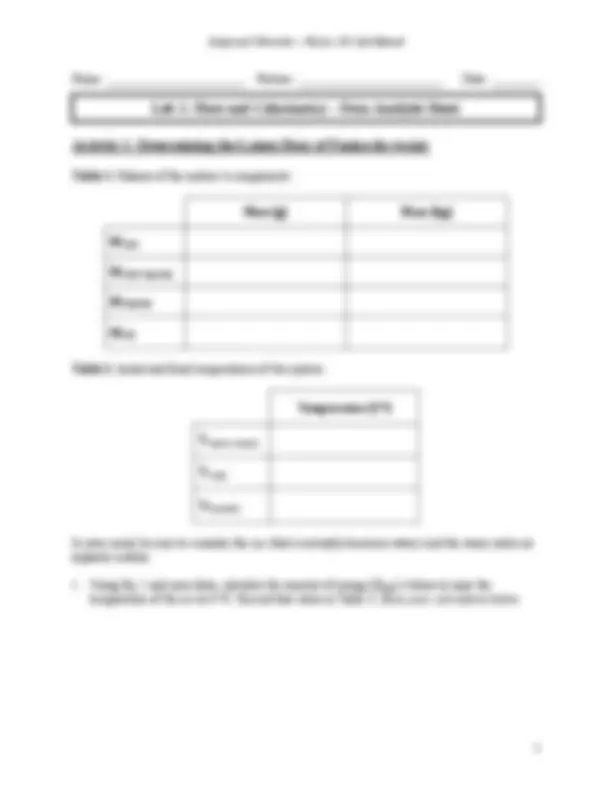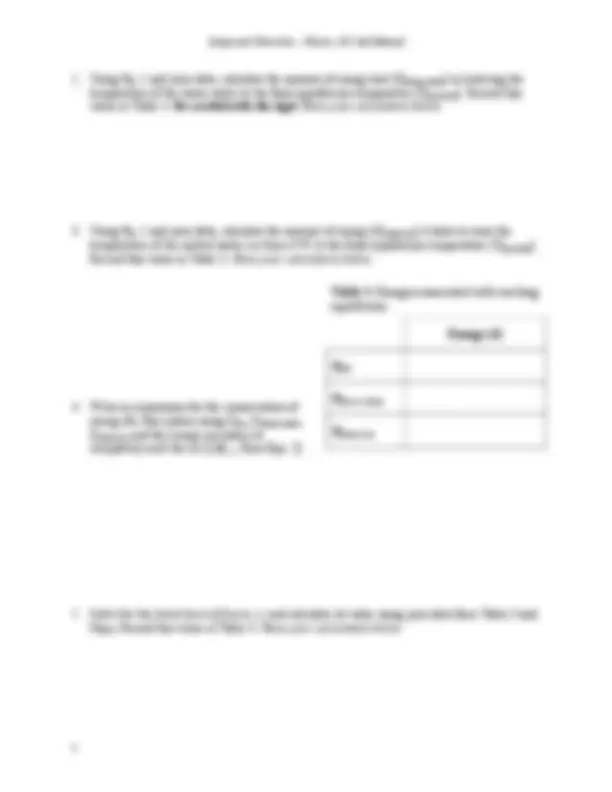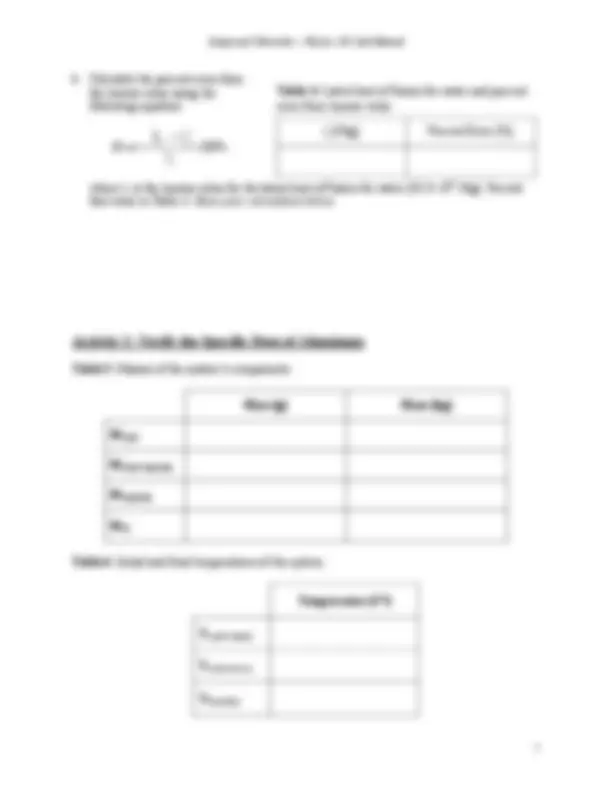





Study with the several resources on Docsity

Earn points by helping other students or get them with a premium plan


Prepare for your exams
Study with the several resources on Docsity

Earn points to download
Earn points by helping other students or get them with a premium plan
Community
Ask the community for help and clear up your study doubts
Discover the best universities in your country according to Docsity users
Free resources
Download our free guides on studying techniques, anxiety management strategies, and thesis advice from Docsity tutors
Material Type: Lab; Class: General Physics II; Subject: Physics; University: Longwood University; Term: Unknown 1989;
Typology: Lab Reports
1 / 6

This page cannot be seen from the preview
Don't miss anything!




Heat is the transfer of energy between a system and its environment because of a temperature difference between them. When two objects in thermal contact with each other come to the same temperature, the two objects are said to be in thermal equilibrium. No heat flows between objects in thermal equilibrium.
Every substance requires a unique amount of energy (Q) per unit mass (m) to change the temperature (T) of that substance by 1° C. This unique quantity is called the specific heat (c). The amount of energy it takes to change a material’s temperature is given as:
Q = mc∆ T (1).
Changing the phase of a material also requires energy. The amount of energy (Q) you must add or gain to change the phase of 1 kg of material is called the latent heat. Each type of transition for a specific material will have a different latent heat. When changing phase from solid to liquid or vice versa, this quantity is called the latent heat of fusion. The energy required to melt or freeze a mass (m) of material is:
Q = lf m (2).
When changing phase from liquid to gas or vice versa, this quantity is called the latent heat of vaporization. The energy required to vaporize or condense a mass (m) of material is:
Q = lv m (3).
In this lab, you will investigate objects in thermal contact coming into thermal equilibrium and use this to determine the latent heat of fusion for water and the specific heat for aluminum.
The principles in this lab should reinforce the following concepts:
Activity 1: Determining the Latent Heat of Fusion for water
Equipment: calorimeter cup, thermometers, water, ice, beaker.
(1) Measure the mass of the cup [MCUP]. Record this value in Table 1 on the Data Analysis sheet. Convert from grams to kilograms.
(2) Add warm water to the cup until it is approximately 1/2∼3/4 full. Measure the mass of the cup + water [MCUP+WATER]. Record this value in Table 1 on the Data Analysis sheet. Convert from grams to kilograms. (3) Calculate the mass of warm water [MWATER]. Record this value in Table 1 on the Data Analysis sheet. Convert from grams to kilograms. (4) Measure the mass of the other cup. In the second cup, add a small amount of ice as discussed in class. Measure the mass of the ice + cup and subtract the mass of the cup to determine the mass of the ice [MICE]. Record this value in Table 1 on the Data Analysis sheet. Convert from grams to kilograms. (5) Place a thermometer in the warm water and measure the initial temperature of the system [Ti(warm water)]. Record this value in Table 2 on the Data Analysis sheet. (6) Use a second thermometer to measure the initial temperature of the ice [Ti(ice)]. Record this value in Table 2 on the Data Analysis sheet. (7) Add the ice to the warm water. Mix the ice and warm water until the ice completely melts. As soon as the ice is totally melted measure the new temperature of the system [Tf(system)]. Record this value in Table 2 on the Data Analysis sheet. (8) Complete the Data Analysis sheet for Activity 1 before moving on to Activity 2.
Activity 2: Verify the Specific Heat of Aluminum
Equipment: calorimeter cup, thermometers, water, ice, beaker, hot plate, aluminum rod.
WARNING: Read through all instructions before beginning. You will be working with boiling water that can scold you if you are not careful.
(1) Measure the mass of the cup [MCUP]. Record this value in Table 5 on the Data Analysis sheet. Convert from grams to kilograms. (2) Add cold water to the cup until it is approximately 1/2 full. Measure the mass of the cup + water [MCUP+WATER]. Record this value in Table 5 on the Data Analysis sheet. Convert from grams to kilograms. (3) Calculate the mass of the cold water [MWATER]. Record this value in Table 5 on the Data Analysis sheet. Convert from grams to kilograms. (4) Measure the mass of the aluminum rod [MAl]. Record this value in Table 5 on the Data Analysis sheet. Convert from grams to kilograms. (5) In a second cup place the aluminum rod with the string outside of the cup and cover completely with water. Place the cup containing the aluminum on the hot plate. Heat the water until boiling. As the aluminum is heating, place a thermometer in the cup of cold water. Measure the temperature right before completing the next step [Ti(cold water)]. Record this value in Table 6 on the Data Analysis sheet. (6) When the water begins to boil the aluminum rod should be in thermal equilibrium with the boiling water (100 °C). Therefore, Ti(aluminum) = 100 °C. (7) Being very careful, remove the aluminum rod from the boiling water using the attached string and place the rod in the cold water. Stir and allow the system to reach an equilibrium temperature. Record the final temperature of the system [Tf(system)]. Record this value in Table 6 on the Data Analysis sheet. (8) Complete the Data Analysis sheet for Activity 2.
Energy (J)
Qice
Qwarm-water
Qwater-ice
Table 3: Energies associated with reaching equilibrium.
K
K f l
l l Error
where lK is the known value for the latent heat of fusion for water [33.3× 104 J/kg]. Record this value in Table 4. Show your calculation below.
Table 5: Masses of the system’s components.
Mass [g] Mass [kg]
MAl
Table 6: Initial and final temperatures of the system.
Temperature [C°°°°]
Ti (cold water)
Ti (aluminum)
Tf (system)
lf [J/kg] Percent Error [%]
Table 4: Latent heat of fusion for water and percent error from known value.